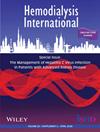The risk factors for arteriovenous fistula dysfunction in maintenance hemodialysis patients: A cross-sectional study
Abstract
Introduction
Arteriovenous fistula (AVF) dysfunction is a prevalent complication among maintenance hemodialysis patients. However, the factors influencing AVF patency remain unclear. To address this, we conducted a study aimed at identifying factors contributing to AVF dysfunction in this patient population.
Methods
The study compared clinical data, vascular calcification score, and laboratory data focusing on blood cell composition and coagulation in 100 maintenance hemodialysis patients in whom an AVF had been inserted from January through September of 2022. The patients were divided into a group in which the AVF functioned without issues and a group in which the AVF was dysfunctional, defined as not able to provide a blood flow of greater than 200 mL/min.
Findings
Patients in the 2 groups (56 in the dysfunctional AVF group and 44 in the group with satisfactory AVF function) were similar demographically. Compared with the normally functioning AVF group, the AVF dysfunction group exhibited significantly higher Agatston calcium scores (20.5 [1.28, 298] median [Q1, Q3] vs. 1.14 [0.00, 11.6]; p = 0.01), elevated triglyceride levels (1.1 [0.6, 1.2] mmol/L vs. 0.5 [0.3, 0.8]; p < 0.01), increased prothrombin activity (113 ± 22.1% vs. 99.4 ± 23.1; p < 0.01), lower prothrombin time (10.4 [9.8, 10.8] s vs. 11.0 [10.3, 11.5]; p < 0.01), higher red blood cell (RBC) counts (3.5 ± 0.7 · 1012/L vs. 3.0 ± 0.7; p < 0.01), and elevated hemoglobin levels (98.0 ± 21.8 g/L vs. 84.9 ± 24.2; p < 0.01). Higher C-reactive protein (20.2 [3.3, 20.2] mg/L vs. 17.8 [6.2, 17.8]; p = 0.01) and procalcitonin levels (0.9 [0.4, 0.9] ng/mL vs. 0.5 [0.2, 0.7]; p < 0.01) were also noted. Logistic regression analysis indicated that platelet/lymphocyte ratio, monocyte/lymphocyte ratio, and RBC count were factors associated with AVF dysfunction. Increased monocyte/lymphocyte ratio and RBC count correlated with higher risk, while a higher platelet/lymphocyte ratio was associated with lower risk.
Discussion
Arteriovenous fistula dysfunction in maintenance hemodialysis patients is associated with higher proportions of specific hematological parameters, particularly elevated RBC count, and altered platelet/lymphocyte and monocyte/lymphocyte ratios.

 求助内容:
求助内容: 应助结果提醒方式:
应助结果提醒方式:


